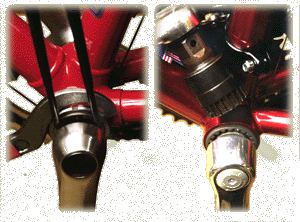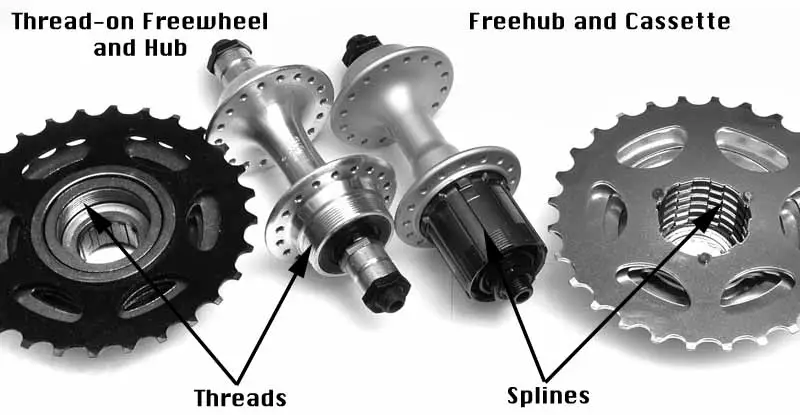Sheldon Brown's
Bicycle Glossary Ca - Ce

|
![]()
In many installations the housing doesn't run along the full length of the cable, but transmits the compressive part of the load to the frame by means of housing stops, fittings with holes large enough for the cable, but too small for the housing to pass through. Some cable stops feature adjusting barrels. This site features an extensive Article on Cable Installation.
Older derailer bikes used either brazed-on or clamp-on guides just above the bottom bracket, but newer bicycles have a guide under the bottom bracket.
The below-the-bottom-bracket option is cheaper, and, for some bicycles with very small chainweels, it eliminates interference betwixt the rear derailer cable and the bottom of the front derailer cage. It also makes cleaning the frame slightly easie.
The above-the-bottom-bracket system is superior in that the cable is shorter and the loop of housing at the rear derailer is not as tight, since the cable stop is atop the chainstay, rather than beneath it.
Poor lubrication of bottom-bracket cable guides is a common cause of autoshifting. Some bicycles use a cable guide on one side of the seat cluster for a rear cantilever-brake cable, rather than to use a short length of housing between two housing stops.
Most experienced cyclists pedal at cadences in the range of 70-90 RPM. This puts less strain on the joints, particularly the knees. Racing cyclists often use even higher cadences for bursts of acceleration.
 A metal or plastic holder for the bearing balls in a ball bearing. Use of a cage keeps the balls from bumping into one another, and allows the use of fewer balls. In the case of traditional cup-and-cone bearings used on bicycles, the primary purpose of caged balls is to save labor. More formally known as a retainer.
A metal or plastic holder for the bearing balls in a ball bearing. Use of a cage keeps the balls from bumping into one another, and allows the use of fewer balls. In the case of traditional cup-and-cone bearings used on bicycles, the primary purpose of caged balls is to save labor. More formally known as a retainer.
![]()
![]()
Most bicycle brakes use a similar mechanism to move the brake shoes inward toward the rim, so they are called caliper brakes. A caliper brake uses a single assembly to move both brake shoes together, unlike a cantilever brake which has a separate unit on each side of the rim.
A brake caliper attaches to the bicycle by a single bolt, through the center of the fork crown or the brake bridge on the seat stays.
Also see the article on caliper brakes.
Some internal-gear hubs use cams to change the engagement of pawls, to select different gear ratios.
See also rollercam brake.
Campagnolo parts are so highly-regarded that Campagnolo's proprietary dimensions have, in several cases, become adopted as de facto international standards. This is particularly so in the case of headsets.
The Campagnolo headset dimensions are 26.4 mm for the fork crown race and 30.2mm for fitting the frame races into the head tube. Other common systems, such as J.I.S., use a larger diameter (such as 27 mm) for the steerer, and a smaller diameter (30 mm) for the head tube. These frame/fork dimensions can be easily machined to fit Campagnolo style headsets.
Campagnolo links:
A recent variation on cantilever brakes is the V brake, which dispenses with the transverse cable altogether. This was adopted for mountain bikes because the transverse cable could snag on a knobby tire if the main cable broke --often resulting in a serious crash.
Traditional cantilever brakes and V brakes have the pivots below the rim. The U brake and roller-cam brake, which have the pivots above the rim.
![]()
![]()
For front derailers, when the derailer is mounted high enough to clear the largest chainwheel, there is a certain minimum size that you need for the smallest ring so that the chain won't be dragging over the bottom of the front cage. Different front derailers have different capacities depending on how tall their cages are. It is expressed in a number of teeth, which is the difference between the largest and smallest chainwheel. For instance, a 52/42/30 crank set would call for a front derailer with a minimum 22 tooth (52-30) capacity.
Front derailers are also designed to be used with a certain size for the largest chain ring. The curvature of the outer cage plate is matched to this size. If you use a different-sized big ring, capacity may be reduced. If the big ring is substantially larger than the derailer is designed for, shifting precision will suffer. If the big ring is much smaller than the derailer is designed for, it may shift OK, but you are likely to have to "trim" the front derailer as you shift the rear derailer to the extremes.
A front derailer for triple chainrings also may need to have an inner cage plate adapted to the size difference between the outer and middle chainrings. If this difference is more than a few teeth, the inner cage plate must be deep from top to bottom, so it can push the chain from small chainwheel to the middle one without overshifting it onto the large one. The cage plate also may have a special shape, intended to improve this shift.
For rear derailers, the capacity relates to the amount of chain slack the derailer can take up, and is equal to the front range (22 in the example above) plus the rear range. Thus, if you have a 52/42/30 crank set, and a 12-28 (16 tooth difference) cluster, the total capacity required would theoretically be 38 teeth (22 front difference + 16 rear difference).
Manufacturers specify this fairly conservatively. They must do so, because they have to assume that some of their derailers will be sold to incompetent cyclists, who will abuse their drive trains by using the smallest chainwheel with the smaller rear sprockets.
Competent riders can considerably exceed the official rated capacity, since they will not misuse the granny ring by running it with the smaller rear sprockets, so it doesn't matter if the chain hangs slack in those gears.
Rear derailers are also commonly designed for a particular maximum size of rear sprocket. If you exceed this size by too much, the jockey pulley may rub against the sprocket when using the lowest gear.
Derailers will also commonly work with larger sprockets than manufacturers' ratings suggest. For instance, Shimano's models designated as "road" derailers are generally listed for a "maximum" sprocket of 27 teeth...because 27 teeth is the largest size that bShimano makes in a designated "road" cassette. However, in almost all cases, these derailers, even the short-cage models, will handle rear sprockets as large as 30 teeth in practice. (This somewhat depends on the design of the frame's derailer hanger, so once in a while you will find a particular installation where you can't use a 30, but I've never seen one where a 28 wouldn't work.)
I'll also mention that many folks seem to be a bit mystified and intimidated by derailers. They're actually quite inexpensive and easy to replace, so it is foolish to allow the limitations of a particular derailer to keep you from having the gearing appropriate to your riding style/needs.
See the Wikipedia article on Screws for more details on this.
Also see my article about the Capreo components.
![]()
![]()
 Bearings which are assembled in a modular unit, as opposed to cup-and-cone bearings, which may be disassembled down to the individual bearing balls for service.
Bearings which are assembled in a modular unit, as opposed to cup-and-cone bearings, which may be disassembled down to the individual bearing balls for service.
Cartridge bearings are the only type of ball bearings used in most industrial products; bicycle technology is the major area where cup-and-cone bearings still survive, but they are in decline even in the bicycle industry. Cartridge bearings are pre-adjusted and generally easier to work with, but on the other hand, cup-and-cone bearings are tolerant of minor misalignment, such as may occur due to flexing of a hub axle or inaccurate machining of a bottom bracket.
| An old-style cup-and-cone bottom bracket. The lock ring wrench is about to loosen the lockring, the pin wrench is engaging two of the holes in the adjustable cup. |  |
A cartridge bottom bracket. The splined tool is shown above the bottom bracket. The crank would need to be removed to actually use the tool. |

Poorly-informed cyclists often misuse this term when they're actually speaking of a multiple freewheel , not a cassette. I have a special article that explains the difference between cassettes and multiple freewheels.
If you're speaking generically about multiple rear sprocket sets, or in other situations where you don't know which type is on a particular bike, the safest generic term is "cluster" which can apply equally to freewheels and cassettes.
Shimano internal-gear hubs with more than three speeds connect the shift cable to the hub by the use of a "cassette joint", which is a pulley mechanism that fits around the axle, just outboard of the sprocket (but inboard of the bicycle's frame. |
 Cassette Joint Cassette Joint |
 Cassette Joint Cassette Joint |
![]()
![]()
An exotic form of casting, called investment casting or "lost wax" casting permits casting of complicated shapes by using single-use plaster moulds that can be broken apart to free the cast part from the mould. This is an expensive process used mainly for high quality lugs and fork crowns.
See also Jeff del Papa's article on Forging, Casting & CNC Machining on this site.
In the case of measuring bicycle frames, all measurements are assumed to be center-to-center except for the seat tube length.
Seat tubes are sometimes measured from the center of the bottom bracket, but the upper end point may vary depending on the measurement system chosen. Center-to-center seat tube measurements measure to the intersection of the center of the top tube with the center of the seat tube.
See also the entry on "Frame Size. "
Some aluminum rims are coated with a ceramic material primarily to improve wet weather braking, and to reduce rim wear that often results when rim brakes are used in muddy/wet conditions.
The ceramic is fairly brittle, and if the rim gets dented even a little bit, the ceramic can flake off. If this happens, the braking will become very rough as the rim grabs/releases at the damaged section.
Most bearing balls are super-hard steel. Lately, some suppliers have been promoting very expensive bearings that use ceramic balls.
These are a silly gimmick, aimed at gullible cyclists with too much money. They have no real benefit in practical use on bicycles.
"A fool and his money are soon parted."
![]()
![]()
![]()
Last Updated: by Harriet Fell